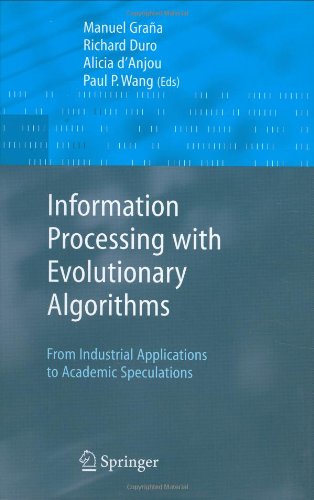

Most ebook files are in PDF format, so you can easily read them using various software such as Foxit Reader or directly on the Google Chrome browser.
Some ebook files are released by publishers in other formats such as .awz, .mobi, .epub, .fb2, etc. You may need to install specific software to read these formats on mobile/PC, such as Calibre.
Please read the tutorial at this link: https://ebookbell.com/faq
We offer FREE conversion to the popular formats you request; however, this may take some time. Therefore, right after payment, please email us, and we will try to provide the service as quickly as possible.
For some exceptional file formats or broken links (if any), please refrain from opening any disputes. Instead, email us first, and we will try to assist within a maximum of 6 hours.
EbookBell Team

4.0
26 reviews
ISBN 13: 9781846281174
Author: Manuel Grana, Richard J Duro, Alicia d Anjou
The last decade of the 20th century has witnessed a surge of interest in num- ical, computation-intensive approaches to information processing. The lines that draw the boundaries among statistics, optimization, arti cial intelligence and information processing are disappearing, and it is not uncommon to nd well-founded and sophisticated mathematical approaches in application - mains traditionally associated with ad-hoc programming. Heuristics has - come a branch of optimization and statistics. Clustering is applied to analyze soft data and to provide fast indexing in the World Wide Web. Non-trivial matrix algebra is at the heart of the last advances in computer vision. The breakthrough impulse was, apparently, due to the rise of the interest in arti cial neural networks, after its rediscovery in the late 1980s. Disguised as ANN, numerical and statistical methods made an appearance in the - formation processing scene, and others followed. A key component in many intelligent computational processing is the search for an optimal value of some function. Sometimes, this function is not evident and it must be made explicit in order to formulate the problem as an optimization problem. The search - ten takes place in high-dimensional spaces that can be either discrete, or c- tinuous or mixed. The shape of the high-dimensional surface that corresponds to the optimized function is usually very complex. Evolutionary algorithms are increasingly being applied to information processing applications that require any kind of optimization.
Adaptive Business Intelligence Based on Evolution Strategies: Some Application Examples of Self-Adaptive Software – T. Bäck
Extending the Boundaries of Design Optimization by Integrating Fast Optimization Techniques with Machine Code Based, Linear Genetic Programming – L. M. Deschaine, F.D. Francone
Evolutionary Optimization of Approximating Triangulations for Surface Reconstruction from Unstructured 3D Data – K. Weinert, J. Mehnen, M. Schneider
An Evolutionary Algorithm Based on Morphological Associative Memories for Endmember Selection in Hyperspectral Images – M. Graña, C. Hernandez, A. d’Anjou
On a Gradient-based Evolution Strategy for Parametric Illumination Correction – Elsa Fernández, Manuel Graña, Jesús Ruiz-Cabello
A New Chromosome Codification for Scheduling Problems – Ramiro Varela, Camino R. Vela, Jorge Puente, David Serrano, Ana Suárez
Evolution-based Learning of Ontological Knowledge for a Large-scale Multi-agent Simulation – A. Lazar, R.G. Reynolds
An Evolutionary Algorithms Approach to Phylogenetic Tree Construction – C. B. Congdon
Robot Controller Evolution with Macroevolutionary Algorithms – J. A. Becerra, J. Santos, R.J. Duro
Evolving Natural Language Grammars – W. Cyre
Evaluating Protein Structure Prediction Models with Evolutionary Algorithms – J. Gamalielsson, B. Olsson
Learning Decision Rules by Means of Hybrid-Encoded Evolutionary Algorithms – J.C. Riquelme, J.S. Aguilar-Ruiz
Evolvable Hardware Techniques for Gate-Level Synthesis of Combinational Circuits – A. Hernández-Aguirre
The Evolutionary Learning Rule in System Identification – Oscar Montiel, Oscar Castillo, Patricia Melin, Roberto Sepulveda
Current and Future Research Trends in Evolutionary Multiobjective Optimization – C. A. Coello Coello, G. Toscano Pulido, E. Mezura Montes
Genetic Algorithms with Limited Convergence – J. Kubalík, L. Rothkrantz, J. Lažanský
Evolution with Sampled Fitness Functions – F. Bellas, J. A. Becerra, R. J. Duro
Molecular Computing by Signaling Pathways – J.-Q. Liu, K. Shimohara
Strategy-Oriented Evolutionary Games: Toward a Grammatical Model of Games – B. Cases, S.O. Anchorena
information processing biology
information on evolution
information processing example
information-processing theory
an information processing theorist
Tags: Manuel Grana, Richard J Duro, Alicia d Anjou, Processing, Evolutionary